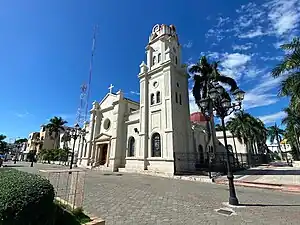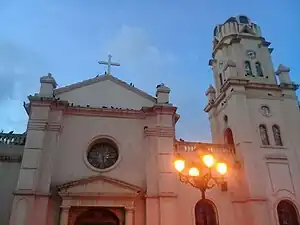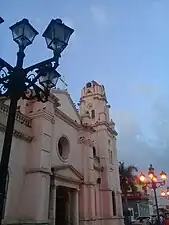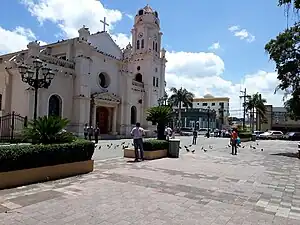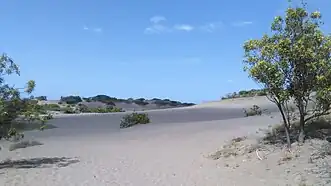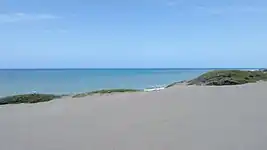Baní
Baní is a capital town of the Peravia Province, Dominican Republic. It is the commercial and manufacturing center in the southern region of Valdesia. The town is located 65 km south of the capital city Santo Domingo.
Baní | |
|---|---|
Municipality | |
| Peravia | |
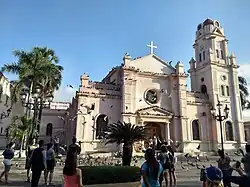 Baní, Dominican Republic town church. | |
 Baní | |
| Coordinates: 18°17′24″N 70°19′48″W | |
| Country | |
| Province | Peravia |
| Founded | 1764 (259 years ago) |
| Municipality since | 1845 |
| Area | |
| • Total | 642.75 km2 (248.17 sq mi) |
| Elevation | 61 m (200 ft) |
| Population (2014)[3] | |
| • Total | 145,595 |
| • Density | 230/km2 (590/sq mi) |
| • Urban | 120,354 |
| • Demonym | Banilejo(a) |
| Distance to – Santo Domingo | 65 km |
| Municipal Districts | 9 |
| Climate | Aw |
Baní is the headquarters of the Southcentral General Directorate of the National Police, the Central Regional Directorate of the Ministry of Agriculture and the South Regional Directorate of the General Directorate of Traffic Safety and Land Transport (DIGESETT).
Overview
The city of Bani is the capital of the Peravia province; its residents also know it as the home of poets. The province's population is 169,865 people, with 61,864 living in the Bani metro area. This is a tightly knit community with families and neighborhoods dating back several centuries.
Bani is a Taino word meaning "abundant water." The area was named after an important Taino leader of the Maguana people. He was said to be one of Caonabo's closest allies. But, it wasn't until 1764 when a group of neighbors concerned with their security and safety came together to purchase a property large enough to build their own village in the valley of Bani. Historians set the sum of this purchase as that of “300 pesos fuertes” for a property called Cerro Gordo; the principals were listed as Francisco Baez and Bartolome del Castillo.
History
The settlement by the colonizers in the Baní plain has its origins in the beginning of the 16th century, during the beginning of sugar production. In its vicinity there were several sugar mills near the Nizao and Ocoa rivers. One of the most important mills was founded by Alonso de Suazo, judge of the Royal Court of Santo Domingo, on the banks of the Ocoa River.
From 1680 to 1684 families from the Canary Islands spread throughout the fields of Santo Domingo, especially through the territories of today's Baní. The city of Bani was officially founded on March 3, 1764 under the governorship of the Spanish Captain, Field Marshal, Manuel de Azlor y Urriés. Don Manuel Franco de Medina (the parish priest) participated in this negotiation, representing the owners, while General Pablo Romero represented the neighbors.
The first authority was Juan Ruíz, appointed governor of the valley in 1740. According to Joaquín Incháustegui, in the years of 1789 Baní had 2,000 inhabitants, mostly of white Spanish origin.
In 1844, the Central Government Board established a territorial division of the Republic, which made Baní a common in the department of Santo Domingo. In 1844 Baní was the headquarters of the “Ocoa Battalion” unit of the Dominican Army made up of soldiers from the region and composed of two Rifle Companies and one of Hunters.
Baní was connected by land with Santo Domingo through the royal road, being a narrow in a trip that lasted around 12 hours, which communicated with the south of the country through the communities of Sombrero, Matanzas, Sabana Buey and Palmar de Ocoa. To transport goods, the sea route was used using schooners, through coastal ports that existed along the coast.
Downtown Baní
Its culture and customs were most accurately portrayed in the novel Bani o Engracia y Antoñita, written by Francisco Gregorio Billini. The local beach is "Playa Los Almendros" (Almendros Beach,) situated 6 km (3.7 mi) south of the center square. The town's original design follows the classic Spanish square, with a park in the center of the town surrounded by the local church and the local government (mayor's office).
The city's Patron Saint is "Nuestra Señora de Regla," whose celebration is on 21 November each year.
Baní is surrounded by many smaller towns, many with their own specific identities. One example is Paya, well known around the country for its milk-based candies (most famously "Dulce de Leche," or Milk Candy.) Another is Salinas, a town by the Salinas bay, where salt is produced. Salinas is famous for its Sand Dunes, that make the Dominican Republic the country with the largest sand dunes in the Caribbean.
Dunas de Baní
Climate
Owing to its location in the rain shadow of the trade winds, Baní has a relatively dry tropical savanna climate (Köppen Aw) with a pronounced dry season between December and April.
| Climate data for Baní (1961-1990) | |||||||||||||
|---|---|---|---|---|---|---|---|---|---|---|---|---|---|
| Month | Jan | Feb | Mar | Apr | May | Jun | Jul | Aug | Sep | Oct | Nov | Dec | Year |
| Record high °C (°F) | 35.5 (95.9) |
36.5 (97.7) |
36.5 (97.7) |
37.2 (99.0) |
36.7 (98.1) |
36.6 (97.9) |
37.0 (98.6) |
38.0 (100.4) |
38.5 (101.3) |
38.0 (100.4) |
37.0 (98.6) |
37.5 (99.5) |
38.5 (101.3) |
| Average high °C (°F) | 31.2 (88.2) |
31.5 (88.7) |
32 (90) |
32.6 (90.7) |
32.6 (90.7) |
32.7 (90.9) |
33.5 (92.3) |
33.5 (92.3) |
33.3 (91.9) |
32.8 (91.0) |
32.3 (90.1) |
31.3 (88.3) |
32.4 (90.3) |
| Average low °C (°F) | 20.5 (68.9) |
20.7 (69.3) |
21.5 (70.7) |
22.2 (72.0) |
22.7 (72.9) |
23.2 (73.8) |
23.8 (74.8) |
23.5 (74.3) |
23.0 (73.4) |
22.5 (72.5) |
21.7 (71.1) |
20.6 (69.1) |
22.2 (72.0) |
| Record low °C (°F) | 14.0 (57.2) |
14.5 (58.1) |
15.5 (59.9) |
16.0 (60.8) |
19.0 (66.2) |
19.0 (66.2) |
20.0 (68.0) |
20.0 (68.0) |
20.0 (68.0) |
18.0 (64.4) |
15.5 (59.9) |
15.0 (59.0) |
14.0 (57.2) |
| Average rainfall mm (inches) | 24.7 (0.97) |
25.7 (1.01) |
23.2 (0.91) |
36.8 (1.45) |
118.6 (4.67) |
135.2 (5.32) |
79.6 (3.13) |
125.0 (4.92) |
131.9 (5.19) |
137.2 (5.40) |
61.0 (2.40) |
29.8 (1.17) |
928.7 (36.54) |
| Average rainy days (≥ 1.0 mm) | 3.7 | 3.4 | 4.0 | 4.4 | 9.4 | 9.4 | 6.9 | 8.5 | 7.8 | 9.4 | 5.2 | 3.5 | 75.6 |
| Source: NOAA[4] | |||||||||||||
Economy
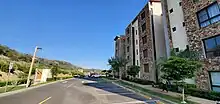
Baní's economy is based on agribusiness. In Baní, different products are processed such as coffee, tomato, corn, pigeon peas, onion, coconut, mango, banana, cashew, milk and salt. The main industries are Peravia Industrial (La Famosa), Industrias Banilejas (Induban), La Fosforera del Caribe, the Banileja free zone and the Punta Catalina Thermoelectric Power Plant. There are also different industries in the construction sector.
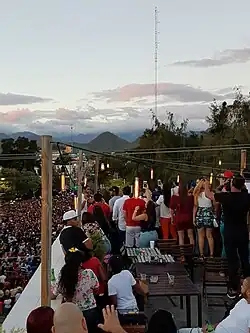
Retail trade is also part of the town's economy. The main shopping centers are the La Maravilla network of stores, the Retailers Association Supermarket, La Sirena and the El Bravo Supermarket. In the services sector, the Las Dunas Restaurant, La Casona Restaurant, Yarey Restaurant and Pizzeria, Fiesta del Chivo Restaurant stand out, as a hotel in the city there is the D"Pravia Hotel, the Caribaní Hotel and as a beach hotel there is the Hotel Salinas and the Hotel Ibiza. The tourism sector is developing in the province with the construction of two large tourist projects such as: Caney Beach Home, located in the Municipality of Matanzas by businessmen Banilejos and the Puntarena project, located in the community of Sabana Ox, by businessman Frank Reinieri.
Peravia Industrial (La Famosa) and Industrias Banilejas (Induban), had their origins in Baní. Valdesia Coffee produced between the mountains of Peravia, San Cristóbal and Ocoa was recognized as a Protected Designation of Origin by the European Union in 2017.
People from Baní
- Willy Aybar – Baseball player
- Erick Aybar – Baseball player
- Manny Aybar – Baseball player
- José Bautista (pitcher) (born 1964) - Dominican Major League Baseball pitcher
- Rafael Cabral, Listin Diario, the main newspaper of the Dominican Republic, Director
- Luis Castillo – Baseball player
- Mario Encarnación – Baseball player
- Wander Franco – Baseball player
- Máximo Gómez –Highest ever ranking officer "Generalissimo" Military leader in Cuba's War of Independence. First ever nominated for the Cuban presidency in 1901.
- Cristian Guzman - Baseball player
- Gilberto Hernández Ortega – painter
- Rafael Landestoy, Baseball player
- Juan Melo - Baseball player
- Timo Pérez – Baseball player
- José Ramírez - Baseball player
- Santaye – singer-songwriter
- Mario Melvin Soto, Baseball player
- Miguel Tejada – Baseball player
- Robinson Tejeda – Baseball player
- Juan Uribe – Baseball player
- Carlos Valdéz – Baseball player
- Luis Vizcaíno – Baseball player
- Pedro Baez - Baseball player
Miscellaneous
- Baní is known for its Mangos "mamellitos"
- Baní is one of the places where the Pulitzer Prize winning novel The Brief Wondrous Life of Oscar Wao takes place.
- The Internationally acclaimed Bachata singers Aventura began their career singing at small clubs gigs in Baní.
References
- Superficies a nivel de municipios, Oficina Nacional de Estadistica Archived April 17, 2009, at the Wayback Machine
- De la Fuente, Santiago (1976). Geografía Dominicana (in Spanish). Santo Domingo, Dominican Republic: Editora Colegial Quisqueyana.
- Censo 2012 de Población y Vivienda, Oficina Nacional de Estadistica
- "Bani Climate Normals 1961-1990". National Oceanic and Atmospheric Administration. Retrieved September 11, 2016.

